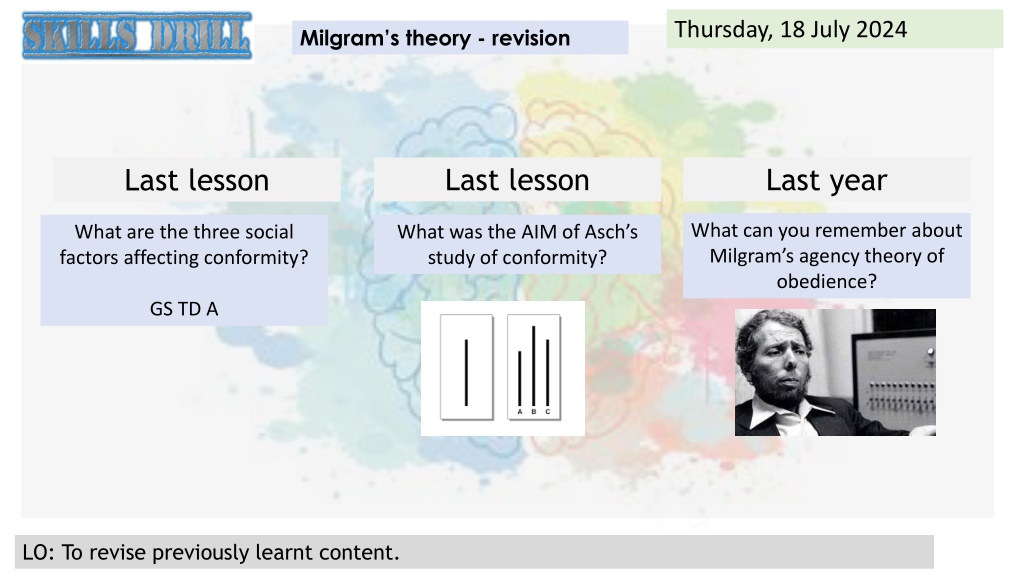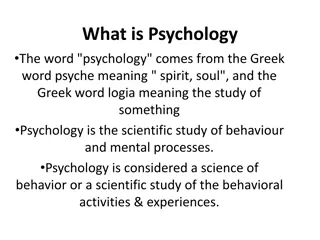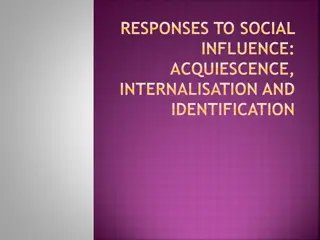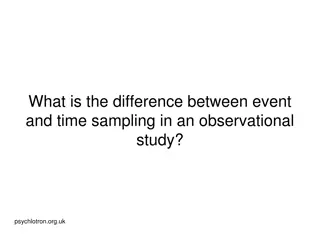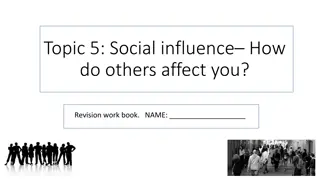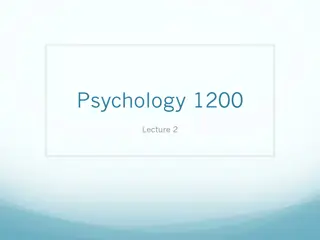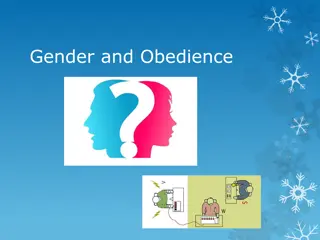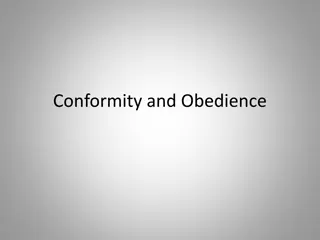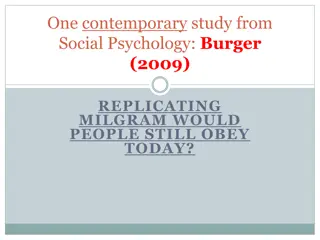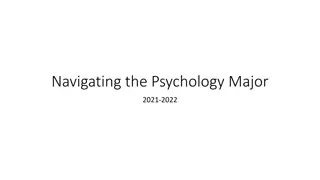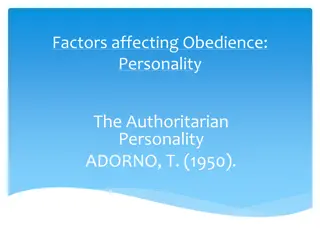Understanding Obedience and Conformity in Social Psychology
Exploring Stanley Milgram's agency theory of obedience, factors influencing conformity, and the distinction between obedience and conformity. Delve into the causes of obedience, the Agentic Theory, and real-world implications of social influence. Reflect on instances of obedience and conformity in daily life to grasp the significance of these concepts.
Download Presentation

Please find below an Image/Link to download the presentation.
The content on the website is provided AS IS for your information and personal use only. It may not be sold, licensed, or shared on other websites without obtaining consent from the author. Download presentation by click this link. If you encounter any issues during the download, it is possible that the publisher has removed the file from their server.
E N D
Presentation Transcript
Thursday, 18 July 2024 Milgram s theory - revision Last lesson Last year Last lesson What can you remember about Milgram s agency theory of obedience? What are the three social factors affecting conformity? What was the AIM of Asch s study of conformity? GS TD A LO: To revise previously learnt content.
Think-pair-share What is the difference between conformity and obedience? You need to know the difference! LO: To revise previously learnt content.
Obedience means following the orders of someone we perceive to be in a position of authority. Conformity means changing our behaviour due to real or imagined pressure from a group. Can you think of two occasions when you have obeyed? (E.g. obeying your parents). Explain Can you think of two occasions when you have conformed? Think about peer pressure. It s important to understand the difference between these two key terms. They are both forms of social influence but why we change our behaviour is very different. LO: To revise previously learnt content.
Obedience and Stanley Milgram LO: To revise previously learnt content.
What is Obedience? To follow an order given by a person with recognised authority over you. Obedience has often been blamed for ordinary people committing horrible acts. https://www.youtube.com/watch?v=mOUEC5YXV8U LO: To revise previously learnt content.
Background From 1939 to 1945 millions of innocent persons were slaughtered on command (Milgram, 1963). What are the causes of such behaviour? Is it in the person or is the situation that they find themselves in? LO: To revise previously learnt content.
Factors that cause obedience Psychologists have tried to understand why we still obey, even when the orders we are given make us do things that we feel are wrong. One of the most famous studies on obedience was conducted by Stanley Milgram Milgram was interested in the apparent contradiction between the ordinariness of men involved in war crimes during the Second World War, and the terrible deeds they had carried out. Their defence? They had only been obeying orders LO: To revise previously learnt content.
Agentic theory From his research, Milgram proposed the agency theory By this he meant: When we act as the agent (representative) of someone in authority we find it easy to deny personal responsibility for our actions it s just doing our job or just following orders. LO: To revise previously learnt content.
Agentic theory This is a situational explanation of obedience This means that people will behave differently in different given situations People have two ways of acting: autonomous they direct own behaviour, and take responsibility for consequences agentic they allow someone else to direct their behaviour, pass responsibility to them LO: To revise previously learnt content.
Milgrams Agency theory key points Milgram s theory explains obedience in terms of power of others and social factors. Autonomous state person makes their own free choices and feels responsible for their own actions. Agentic state person follows orders with no sense of personal responsibility. LO: To revise previously learnt content.
Milgrams Agency theory key points Authority Agentic shift the change from autonomous to an agentic state. The shift occurs when a person sees someone else as a figure of authority. LO: To revise previously learnt content.
Milgrams Agency theory key points Culture Societies have a hierarchy with some people having more authority than others. This hierarchy is agreed on by all members. The culture we live in socialises us to respect the social hierarchy. LO: To revise previously learnt content.
Milgrams Agency theory key points Proximity Proximity how close someone is to us when they give an order. As proximity increases a person begins to feel a greater sense of personal responsibility and is less willing to obey. As proximity increases obedience is likely to decrease. LO: To revise previously learnt content.
Milgrams theory evaluation One strength of the agency theory is that there is research support. Milgram s own research demonstrated how the majority of ordinary people will follow instructions even when they are acting against their conscience. Blass and Schmitt (2001) found that people who saw Milgram s study blamed the experimenter, indicating that they believed the participants were agents of authority. The explanation is also supported by many historical events which demonstrate that as a result of social factors, normal people can act in a callous and inhumane way. Point Evidence/example Explain LO: To revise previously learnt content.
Milgrams theory evaluation A weakness of the agency theory is that this explanation excuses people who blindly follow destructive orders Some people consider a situational perspective on the Holocaust offensive because it removes personal responsibility from the perpetrators. To suggest that Nazi executioners of Jewish people were 'only doing their duty by obeying orders' implies that they were also the victims of situational pressures, and that anyone faced with a similar situation would have behaved in the same way. The explanation therefore runs the risk of trivialising genocide. Point Evidence/example Explain LO: To revise previously learnt content.
Milgrams theory evaluation Another weakness is that agency theory can t explain why there isn t 100% obedience. In Milgram s study 35% of the participants didn t go up to the maximum shock of 450 volts. Point Evidence/example This means that social factors cannot fully explain obedience. Explain LO: To revise previously learnt content.
1. Complete the activities in your booklet. 2. Complete the activities in revision guide for this topic pg 102. LO: To revise previously learnt content.
Q1. Feeling responsible for your own actions is a description of: a. An agentic state b. An autonomous state c. Obedience d. Conformity. LO: To revise previously learnt content.
Q2. The term agentic shift means we obey because we switch from: a. Seeing an authority figure as illegitimate to seeing them as legitimate b. An autonomous state to being an agent of an authority figure c. Believing an authority figure cannot punish us to believing that they can d. Believing an authority figure has status to believing they don t. LO: To revise previously learnt content.
Q3. In Milgrams study, increased proximity between participant (teacher) and learner: a. Made participants more obedient b. Made participants less obedient c. Reduced the participants moral strain d. Made no difference to obedience. LO: To revise previously learnt content.
Q3. Obedience is best explained by: a. Social factors b. A combination of social and dispositional factors c. Cultural factors d. Dispositional factors. LO: To revise previously learnt content.
Q5. In terms of group size, Asch found: a. Conformity increased with group size but only to a point b. Conformity kept increasing with group size c. Conformity decreased as group size increased d. Increasing group size had no effect on conformity. LO: To revise previously learnt content.
Lets think about what we have learnt today. 1. Tell me something new that you have learnt today. 2. What knowledge/skills have you used today from previous lessons? LO: To revise previously learnt content.
